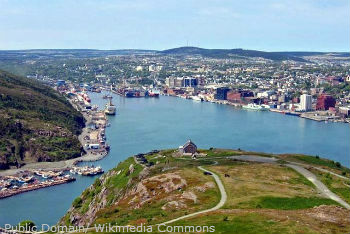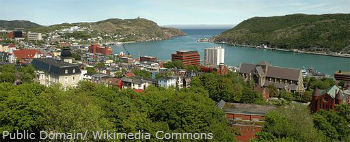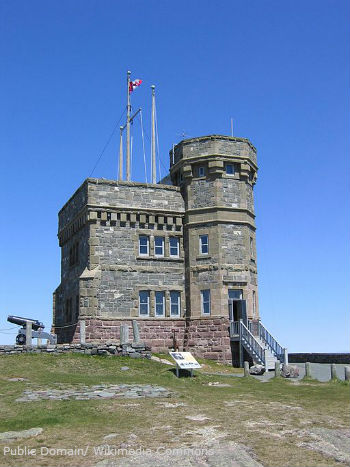Often considered North America’s oldest city, St. John’s in Newfoundland and Labrador is unlike any other city in Canada. This coastal settlement has a distinct style with short, multi-coloured buildings that abide by St. John’s strict heritage regulations, making it look vibrant and accessible.  If you want to relocate to this historic capital, read on for the necessary information to make your move go smoothly. St. John’s Climate Despite its northern location, St. John’s is not terribly cold, due to its placement in the Gulf Stream’s warming path. The Gulf Stream climate also causes seasonal lag, so February is the coldest month in St. John’s and August is the hottest. The daily average temperature in the winter is -5 degrees Celsius, which is mild for a city at St. John’s latitude. The average winter high often approaches or reaches the freezing point, so St. John’s has the mildest winters in Canada outside of British Columbia.
St. John’s summers do not get very hot. The August daily mean is 21 degrees Celsius, which is about room temperature. In fact, the record high for the city is under 32 degrees Celsius, so there may never be a day where you feel uncomfortably hot.
It’s not all good news, though-- St. John's does have some bad weather. The city gets over 1,500 millimetres of precipitation each year, including meltwater from 335 centimetres of snowfall. Thunderstorms are common during the warmer months, but most of the heaviest precipitation occurs in the winter. St. John’s location on the Eastern tip of Northeast Canada makes it susceptible to tropical storms that often travel up the East Coast of the US. Although rare, occasionally these storms will still be strong enough to be categorized as hurricanes when they reach St. John’s.
According to Environment Canada, St. John’s has the most fog, wind, and cloud cover of any major Canadian city. It is not exactly a good place to go tanning. St. John’s Neighbourhoods St. John’s has a variety of neighbourhoods framed by Signal Hill and St. John’s Harbour.
St. John’s Downtown is just north of the harbour and is filled with artists, tourists and businesses. While the city does not have any skyscrapers, (no building is more than 13 storeys in St. John's) it does have several hotels and office buildings in its downtown area.
While St. John’s city council discourages tall buildings, it is all for multiple colours. This unique architecture is on full display when viewing Jelly Bean Row, a series of colourful homes and business located near the waterfront.  Another uniquely St. John’s neighbourhood is the Battery, which is located on the slope of Signal Hill going down towards the harbour. Most homes in this neighbourhood are built on an angle and are only accessible by winding, steep roads that may remind Americans of San Francisco. There have been a few mudslide/avalanche disasters that destroyed homes in this precarious-looking neighbourhood, but none have occurred since the 1950s.
The southwest section of the city has more rural, less congested housing options in neighbourhoods like Goulds. This particular neighbourhood was annexed in a 1991 amalgamation. Registering Your Car in St. John’s To register your car in St. John’s, you need to follow Newfoundland Labrador regulations. If you are moving from outside of that province, you will need to provide some information before your car can be registered. Typically you will need: - A valid license
- Proof of ownership
- Proof of sufficient insurance
- Passage of inspection
For information on what you need and where to go, head to Service NL. You can use the provided phone numbers to call and set up an appointment at the local motor registration office. St. John’s Transportation St. John’s location on the east coast of Canada makes it an important transportation hub. - The city is the eastern terminus of the huge Trans-Canada Highway.
- St. John’s Harbour is home to many Canadian Coast Guard ships, but also serves as a port.
- St. John’s International Airport is Atlantic Canada’s second busiest airport.
Metrobus Transit operates the city’s public transportation. Commuters can use 19 routes serviced by 53 buses to get where they want to go in St. John’s.  In 2009, the city initiated the St. John’s Cycling Master Plan to give commuters more options for riding a bike in the city. This plan called for the construction of 43 kilometres of bike lanes, 20 bike parking areas and the inclusion of bike racks on the Metrobuses. St. John’s Schools The majority of St. John’s elementary and secondary schooling is administered by the Newfoundland and Labrador English School District. As the city’s English-speaking public school option, the ESD has the most students in the province. St. John’s also has one public school that belongs to the province-wide francophone school district. St. Bonaventure's College and Lakecrest Independent are St. John’s only private elementary and secondary schools.
The Memorial University of Newfoundland is the city’s largest post-secondary institution and is also the biggest university in Atlantic Canada. Its Marine Institute is also located within St. John's and boasts one of the country’s cheapest tuition rates.
The College of the North Atlantic is a St. John’s public college that offers trade and transfer programs to St. John’s residents. St. John's also has several private colleges, including Academy Canada, Eastern College, and Keyin College. St. John’s Economy St. John’s was traditionally a fishing town, but that changed when the industry collapsed in the 1990s. After a period of economic depression, the city once again became productive when it started using oil and gas as natural resources.
St. John’s is also Newfoundland and Labrador’s capital, so the provincial government is the city’s leading employer.
St. John’s major employers include:
- Newfoundland and Labrador government
- Memorial University of Newfoundland
- ExxonMobil Canada (headquarters)
- Chevron
The combination of government jobs and the city’s new identity as Eastern Canada’s oil and gas centre has made St. John’s very prosperous in recent years. The Conference Board of Canada reported in 2013 that St. John’s had the second highest per-capita GDP in the country, at $52,000. St. John’s Cost of Living St. John’s has a moderately low cost of living when compared to similar Canadian cities. For the most part, this is because of lower real estate prices. Be advised that these prices will go up as more people move to St. John’s, which is the current trend.
Renting a one bedroom apartment in St. John’s city centre should only cost around $1,000 a month, while finding a similar room in the more rural outskirts can bring the price down to $800.
Other expenses like utilities, groceries, gasoline and transportation are all average for a city of St. John’s size. Unlike the western oil cities, like Edmonton, St. John’s does not get a huge discount on gas prices. One litre of gas costs about $1.40 in St. John’s. St. John’s Culture and Contemporary Life St. John’s is a colourful city in many ways, and it offers similarly vibrant entertainment options to tourists and residents.  Water Street, Duckworth Street, and George Street are all downtown tourism and nightlife hotspots. The city’s trademark multi-coloured buildings are everywhere on these streets, which are lined with shops, restaurants and bars. George Street is specifically known for its nightlife because it has a very high density of bars and pubs that stay open later than most establishments. It also hosts an October Mardi Gras festival and the George Street Festival every August.
If you’re more interested in art than nightlife, you can head to The Rooms, a combination of several local museums and archives that acts as St. John’s cultural headquarters. This National Historic site of Canada contains the Art Gallery of Newfoundland and Labrador, the Provincial Archives of Newfoundland and Labrador and the Provincial Museum of Newfoundland and Labrador. It also is one of the biggest buildings in the city and can be seen from almost anywhere in St. John’s.
St. John’s also has some parks to enjoy. Pippy Park in the eastern part of the city is one of Canada’s largest urban parks. It contains two golf courses, campground, trails and protected natural areas.
Signal Hill is one of St. John’s most popular tourist attractions. It was where Marconi first received a transatlantic wireless signal and its view of the city and the surrounding Atlantic Ocean made it an important place for fortification in military conflicts. The view now serves as one of many reasons why tourists love the site. St. John’s Moving Resources Have you decided to move to St. John’s? You probably can’t do it on your own--hire a reliable moving company to provide you with all the services you need at Movers.com!. Make sure to always get at least three different estimates from three different companies before choosing one for the job. This will let you compare prices and get the best rate for your move! St. John’s Relocation Tips - Take advantage of the city’s many bike lanes and try biking to work to save gas money.
- Don’t expect there to be many jobs in the fishing industry. That ship sailed in the 90s.
- Make sure you have a taste for St. John’s unique style. The short, colourful architecture can be jarring if you aren’t prepared for it.
- Prepare for frequent wind, fog and precipitation in St. John’s.
Helpful links |